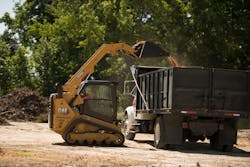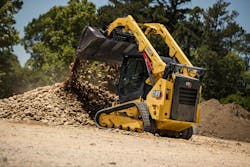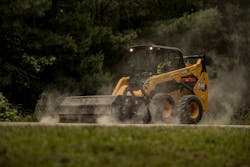When planning out your purchases and upgrades for your fleet, what priorities come to mind? Will you be splurging for hot-button items, or has a tried-and-true necessity made your list?
Are machine control enhancements and telematics on the top of mind? Or maybe you’re looking at the newest excavator that was on display at CONEXPO-CON/AGG?
New, super-strong and super-precise machines to add to your fleet are certainly exciting, but not everyone gets energized about the fundamentals like wheels and tracks.
The newest wheels and tracks out on the market today for the modern excavator, backhoe, or hauler are meant to help operators get their job done effectively, efficiently, and safely, without damaging the machine being used. A good-quality tire or track can significantly extend the lifespan of your equipment, and too-old tires or tracks could be a financial drain and a safety hazard.
Kevin Coleman, a Caterpillar product specialist, says when it comes to buying tracks for compact track loaders (CTL), for example, contractors are looking for the best bang for their buck. They’re searching for value over the long haul.
“For CTL tracks, contractors are looking for the best value. That doesn’t necessarily mean the cheapest purchase price,” he says. “A less expensive track may need to be replaced more often vs. an OEM track that has been designed and tested for the host machine.”
He says the original equipment manufacturer (OEM) tracks may cost a bit more initially, but they will be able to perform for a long service life before they’ll need to be replaced, so their annual cost ends up being more affordable. This is especially true when compared to more generic products, he says.
“Contractors are also looking for a selection in track tread patterns so they can select the tread that best fits their needs,” says Coleman. “As an example, a contractor’s application may drive the need for a lower ground disturbance tread, such as a bar tread pattern.”
Each job has unique challenges, so each job may require unique tools. Tires and track design can be specialized for particular equipment, but flexibility is also a consideration, Coleman says. Contractors are looking for tracks and tires that can hold up under a variety of situations that one could come across while on different job sites.
“For CTLs, the tracks have to meet a wide range of conditions due to the versatility of the machines themselves,” he says. “The applications they operate in could be flat, uneven, sloped, be on the concrete or dirt, contain stumps, rocks, or construction debris. The tracks have to be able to handle all of these conditions and allow the machine to perform the work that the customer needs to accomplish while delivering a long life.”
Off-The-Road (OTR) tires for construction and grading professionals are designed with deep tire tread—and often with various lines and/or shapes of treading depending on the type of job requirements—for better traction when the ground is wet, muddy, snowy, when soil is loose, or when working on a slope. Deeper treads are, essentially, teeth that the tire can use to create more friction and avoid slipping in tough conditions. Additional treads can also increase that traction.
Tires are designed with traction, machine wear life, tire wear life, and workload in mind. Picking the right tire for your fleet means balancing these requirements for each machine, keeping in mind what jobs you expect each piece of equipment to complete.
The newest tire and track options on the market today often feature new tread patterns, Coleman says. Caterpillar’s newest options for tracks for their compact track loaders have rubber tracks with either a block-style tread pattern or a bar-style tread pattern. The bar tread and the block-style tread are both designed with steel embeds and longitudinal steel cords, he says.
“However, the bar-tread rubber track differentiates itself in its ability to minimize ground disturbance, making it ideal for landscapers who perform finish grade work,” he says. “The narrowly spaced bars leave behind a series of narrow, parallel ridges that are easily knocked down with a rake before installing sod or other finishing products. The bar-style rubber track tread also offers extra traction when operating in snow, especially compared to the block tread pattern.”
Ryan Lopes, national product manager for material handling and solid tires at Alliance Tire Americas, a tire manufacturing company, says among their newest products, the Alliance 585 is an off-the-road tire that uses unique treads to focus on traction.
“The tread pattern is also an improvement over conventional straight or curved bar treads that we usually see on backhoes,” he says. “The Alliance 585 has a non-directional tread design comprised large, sturdy blocks that provide more biting edges for traction, better self-cleaning and mud breaking, and a smoother ride on the road.”
Lopes says tire design and creation are carefully considered, from the materials used down to the placement of treads.
“As a tire manufacturer, we work to address the need for flotation, traction, and the added benefits of roadability and reduced cost by building both bias-ply and radial tires,” he says.
Another aspect of some of today’s newest tire and track product offerings is the makeup of the tire's materials. Lopes says the Alliance 585 is a multi-surface tire that was developed to have the benefits of a steel-belted radial tire with the price point of a bias-ply tire.
“The Alliance 585 is a highly sophisticated, beautifully crafted tire that offers excavation contractors a great way to get into radials in a cost-efficient way,” he says. “Alliance is a global leader in constructing large OTR tires with steel, and we put that expertise to work to give the 585 a large, evenly distributed contact patch.”
He says the steel radial belts in the Alliance 585 would be features one might expect “in a much higher-priced tire.” The larger footprint of the tire makes it more effective at transmitting horsepower to the ground itself, which improves machine productivity, reduces the likelihood of slipping, and increases the machine’s fuel economy by not losing any energy by spinning one’s wheels.
He added that the steel belts of the Alliance 585 are particularly puncture-resistant, and the sidewalls of the 585 are also reinforced against puncturing.
Coleman says longevity should be the biggest consideration when weighing the cost of tracks or tires. He says it’s wiser to pick a tire that will come to a better cost-per-year price than weighing costs based on sticker price alone.
“OEM tracks are designed and tested to deliver the highest performance and life for the machine,” he says. “While there are other options available to customers at lower prices [than Caterpillar’s tracks], not all tracks are equal. For tracks, you get what you pay for. With less expensive, non-OEM tracks, the thickness and quality of the rubber and steel used can vary, which can affect the service life of the track along with high-quality manufacturing processes."
Lopes says one important factor for skid-steer tires is picking tires that can resist wear and tear. He says Alliance Tires is planning to release a new skid-steer tire, the Galaxy Mighty Trac ND Multiple-Terrain tire, that includes an abrasion-resistant compound, which he says is particularly important due to the amount of scrubbing skid-steers do when they are turning and reversing.
“Whether you’re on pavement or in sand, loose soil, or snow, the siped blocks on the Mighty Trac provide great traction and self-cleaning,” he says. “There’s a lot of engineering in the tread design—our design team has optimized the shape of each block to maximize tire life and traction.”
Lopes says track selection is also important for contractors, who often work exclusively on soft ground since the larger contact area is essential for that type of job site. Such difficult terrain requires careful consideration when selecting tracks.
What sort of challenges can a good tire expect to handle when taken to a job site? Lopes says it’s likely those tires will have to handle every tricky situation in the book—and then some.
“Grading and excavating contractors face nearly every possible challenge,” he says. “Mud, sand, snow, rocks, gravel, demolition debris, and pavement—which is remarkably good at wearing down tires—are all in a day’s work. When we develop a tire for a backhoe, dozer, excavator, skid-steer, or grader, we tackle it as if we’re building a mining tire: we use all our design, technology, and manufacturing capabilities to create a tire that is really going to encounter hard duty.”
When looking for a good tire, Coleman says, contractors want to focus on their bottom line. What are they getting for their money? Will the return be worth the price tag?
Lopes says this important question is one of the biggest considerations for any contractor, and tire manufacturers take their responsibility seriously. Without a reliable tire, a very, very expensive piece of equipment could be benched mid-job.
“Will it be dependable so the contractor doesn’t have downtime because of punctures or premature wear?” he says. “If a tire failure sidelines a machine, that machine is not making the contractor money—it’s costing him or her money. Full stop. They need a tire that is going to keep running.”
That cost is also important to weigh when considering the total cost of ownership year over year. Does this type of tire require regular replacement after certain jobs? Do they hold up on multiple types of jobs and for a substantial amount of time?
“It may cost a little more to purchase…but the longer it lasts, the lower the cost-per-hour, or total cost of ownership, becomes,” says Lopes. “And if it improves fuel economy and makes a machine more effective, the contractor is getting an even bigger return on investment.”
Picking the right tread pattern for specific jobs can also increase a machine’s performance and maximize tire lifespan, although it does require more upfront financial investment, Lopes says. He says selecting the right treat pattern will improve productivity by picking the most efficient tool for the job.
“If you often run in loose, wet soil, a block pattern like the Alliance 580 would be more prone to caking with mud, so a lug might be a better choice,” he says. “If your machine does a lot of roading or operates most of its time on a hard, paved surface, a lug pattern might wear too quickly, so a block tread like the one found on the Alliance 585 may be a better choice—and the way we have arrayed the blocks in a curved, lug-like arc, it’s also great in loose soil. For winter work, especially in snow, the Alliance 550 and 551 are optimal.”
He says it’s important to work with a tire supplier that is not only going to have good customer support and warranties, but a tire expert who is going to help you pick the right tires for your jobs the first time.
“If you’re mostly on pavement, look for tires with really huge tread blocks that can minimize wear,” adds Lopes. “If you’re mostly working in mud or soft soil, look for a tread pattern that has more biting edges for traction and better self-cleaning capabilities. And if you’re in Florida, a siped snow tire is not for you.”
In addition to block treads, radial treads are more popular now for heavy machinery, and this has led to more efficient tires that last longer, he adds.
“We’re also introducing more radials like the steel-belted Alliance 585 for backhoes, the all-steel Galaxy MGSR 200 for graders, and a wide range of other Alliance and Galaxy tires,” says Lopes. “Because radials can improve traction, fuel economy, and productivity—and last longer because of more even tread wear and less heat buildup—we strongly believe they will be much more widely adopted for grading and excavation in the next few years, much as radial tires came to dominate the car and truck industries in just a few short years.”
Improvements in tread manufacturing mean tires can handle their payloads without as much shock to their systems, which means less maintenance. It also improves traction, which leads to better safety, more fuel efficiency, and faster performance. But it wasn’t always this way, and tread engineering stayed pretty much the same for about the past 100 years.
Tread used to be limited to a bar tread, which is an off-set V-shaped pattern using parallel, diagonal treads across the diameter of the tire, Lopes says. This type of tread provided grip on soft ground but didn’t provide the extra benefits of today’s tread types.
"For generations, backhoes, loaders, and skid-steers employed a bar tread, either the 100-year-old, curved R-1 tractor style or the straight bar lugs you see on R-3 tires," he says. "What's important and remarkable is how complicated it is to optimize a tread. Every aspect of a tread block—everything about its shape, dimensions, and where it is placed in relation to the other blocks—impacts its effectiveness. Design and engineering are critical. We also put a great deal of effort into compound chemistry, developing the proper balance of chip resistance, wear resistance, stiffness and flexibility, and heat dissipation for each tire.”
Lopes says today’s research and development has “multiplied the effectiveness” of the most recently released tires compared to the classic tires of the 1900s. He says factors like tread blocks deliver better traction, clean themselves of dirt and debris more effectively, can perform in a wider set of difficult conditions, and can drive more smoothly on the roadway. Bar treading isn't well-suited for road driving, except in snowy conditions.
“Basically, [bar treading provides] everything a grading and excavation contractor needs,” says Lopes.
Additional industry improvements include enhancements to beat packages that attach the tire to the rim, which he says his company worked on. More R&D advances include treads with steel-belted support and reinforced tire sidewalls, Lopes says of Alliance Tire.
“We are proud that our compound engineers and our manufacturing team have mastered the art of working with steel in particular,” he says. “Their expertise in building large tires with steel radial belts allows us to develop tires like the Alliance 585 radial, which is important and unique in the market.”
Steel isn’t the only material that’s making headway in the tire and track industries. Tires are made of silica, rubber, carbon black, and other ingredients, as well as synthetic fibers in the radial belts and plies, Lopes says.
“Getting all of those components to adhere to each other and maintain their integrity even when a tire is getting pounded on the job site or run until it’s too hot to touch is a truly remarkable feat of chemistry,” he says.
All in all, the significant amount of research and development visible in today’s tires and tracks, and every part of the tire and track, seem to be affected. From the treads outside to the initial ingredients used to form the casing, from the backup reinforcements to the materials that hold the tire together, hardly any part of the tire has been left unimproved.



